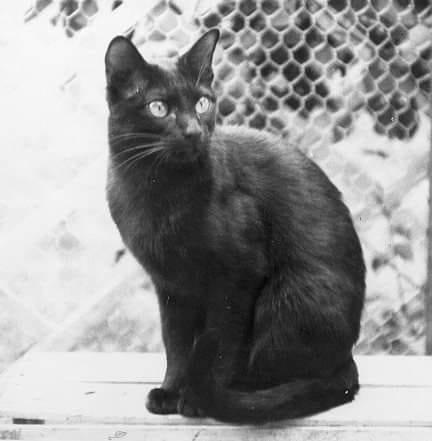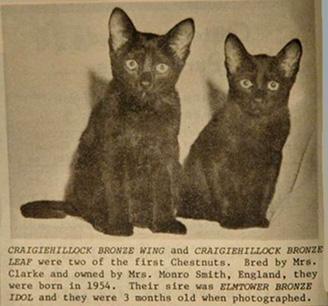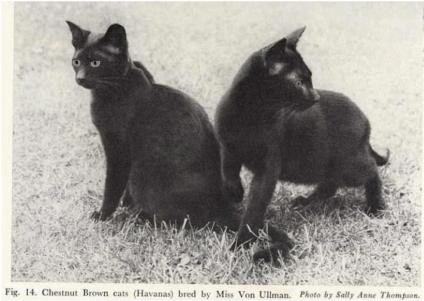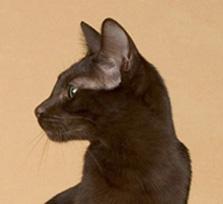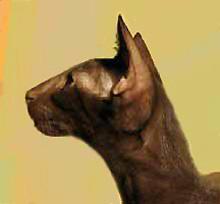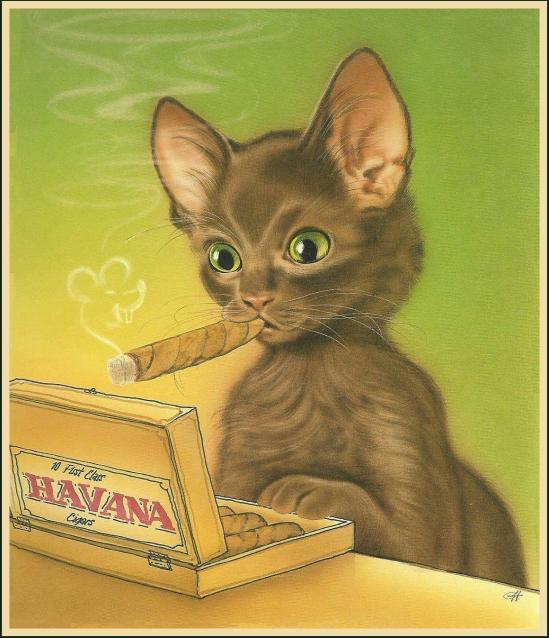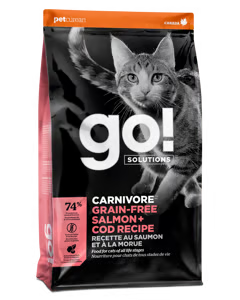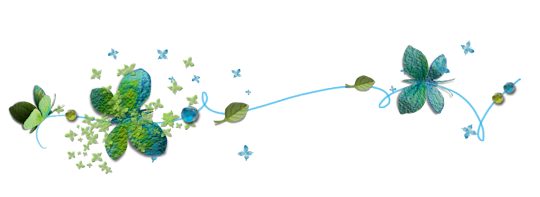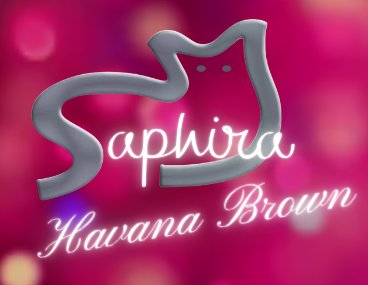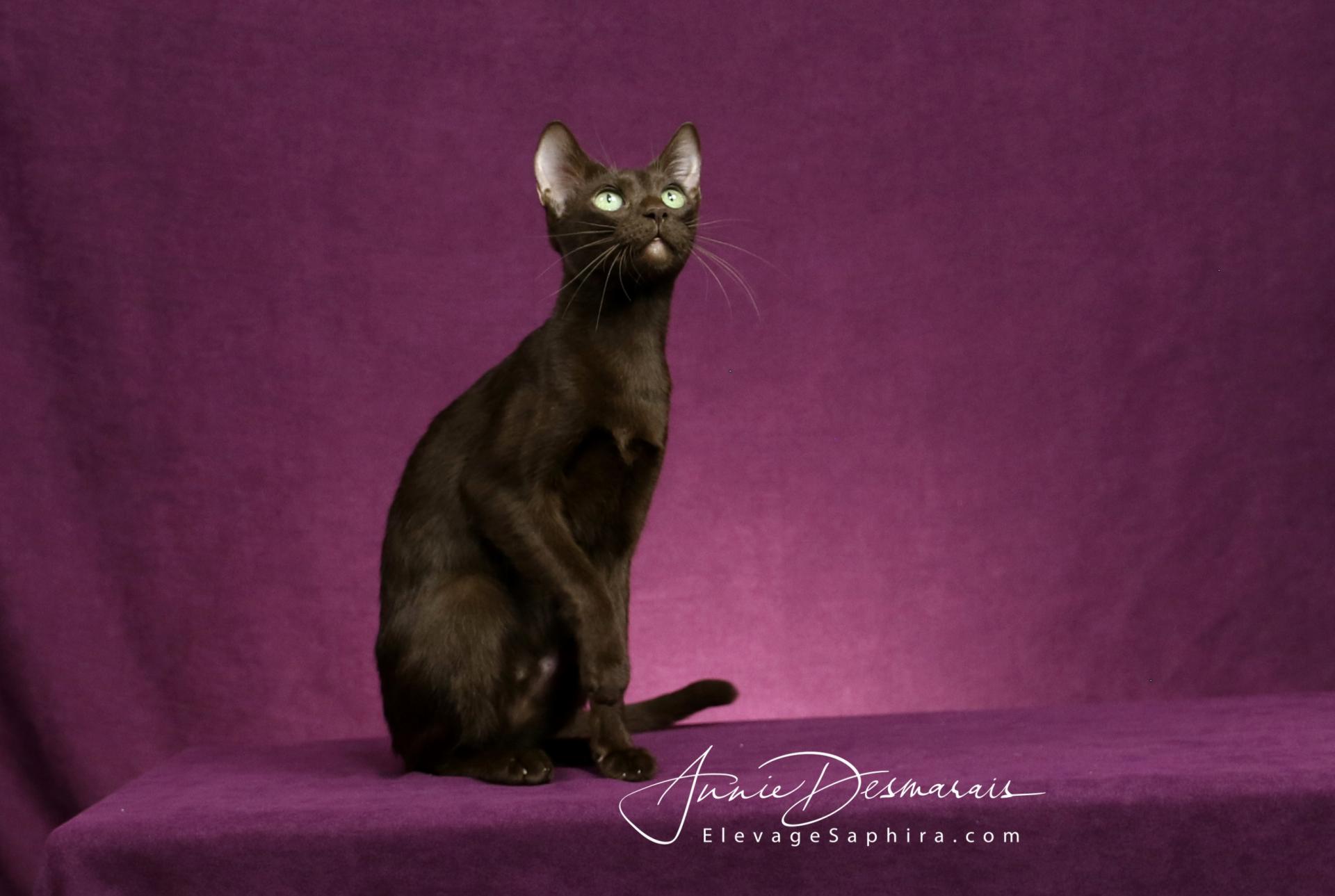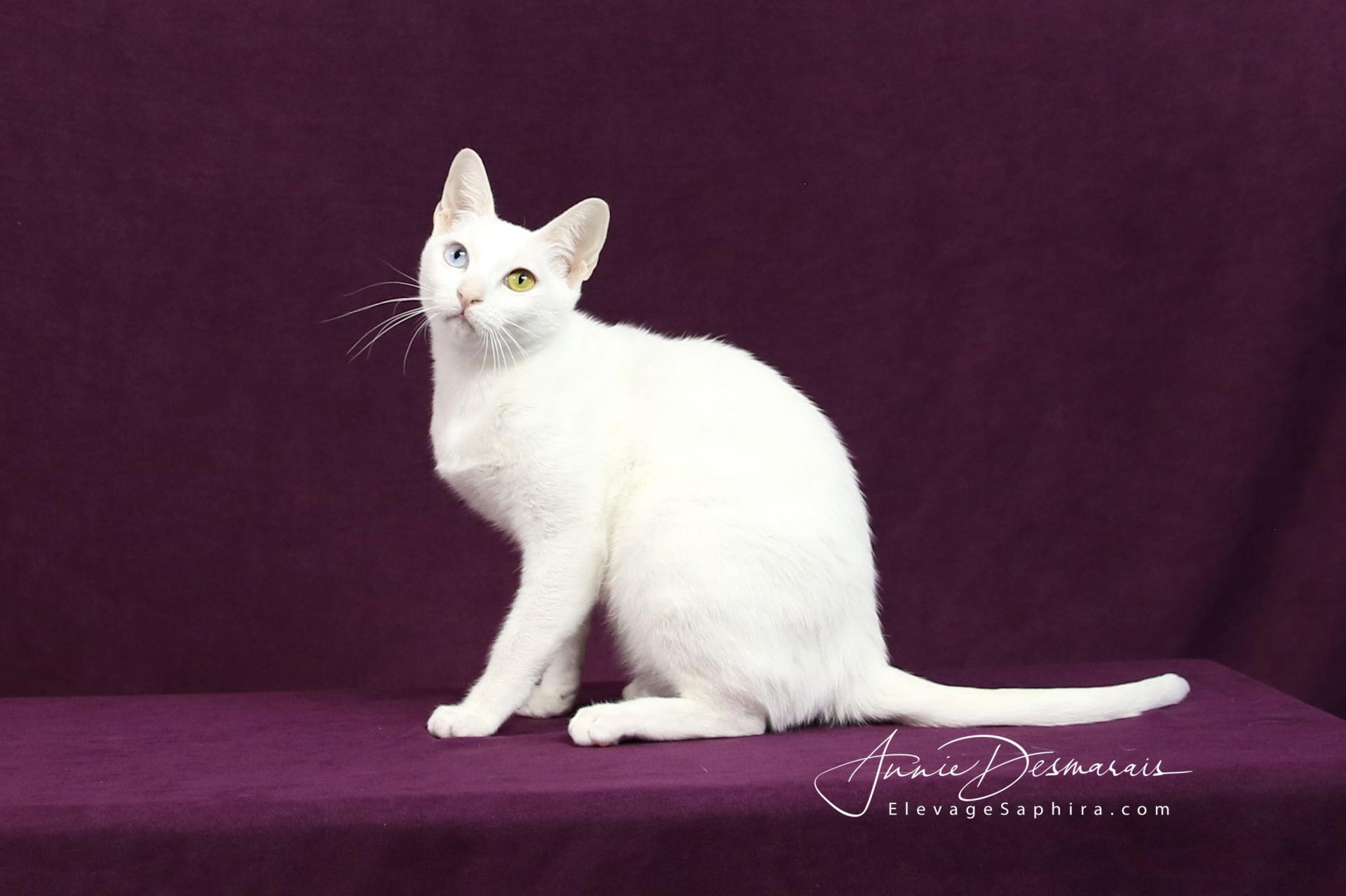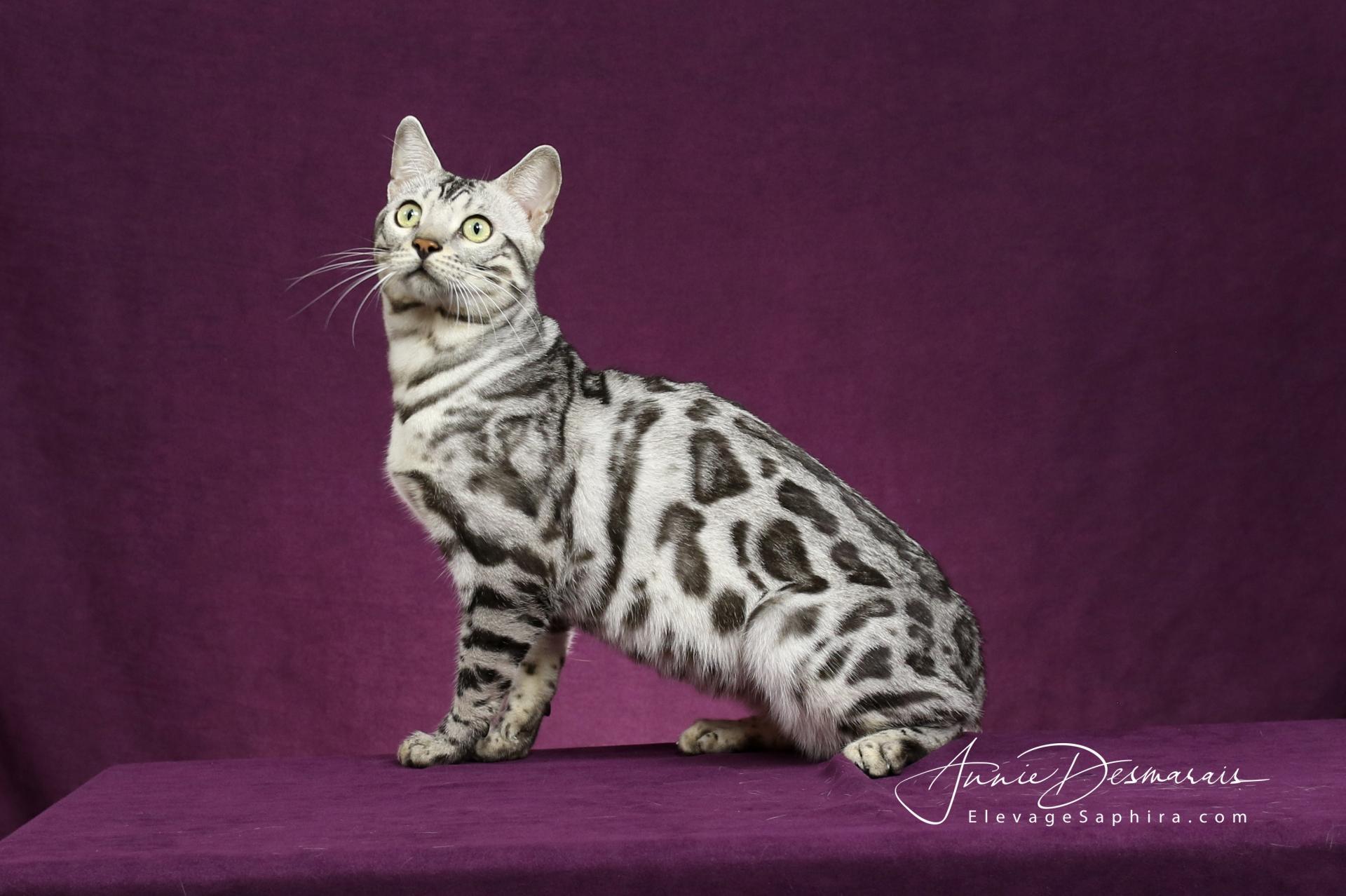Havana Brown - The Breed
The Origins
We could see the first brown cats in cat shows in the United Kingdom as early as 1894. The name given to these cats was ''Swiss Cat Mountain''. Later, these brown cats lost the favor of English breeders in the 1920s, so the breeders stopped breeding them.
However, the interest returned at the beginning of the 1950s. Indeed, 5 breeders of Siamese, located in England, began to work with the genetics of the colors of the cats and within the framework of their tests, they undertook to develop a brown cat of solid color, having a body as elegant as the Siamese of foreign type.
This group of breeders consisted of Mrs. Armitage Hargreaves of Laurentide Cattery, Mrs. Munroe-Smith of Elmtower Cattery, Baroness Von Ullmann of Roofspringer Cattery, Mrs. Elsie Fisher of Praha Cattery and Mrs. Judd of Crossways Cattery. These dedicated English breeders have studied the available genetic information and have kept detailed records of their experiences.
Breeding a brown cat with another brown cat was impossible because there were not enough brown cats. But the English breeders knew that historically, there had been a brown cat born as a result of an accidental mating of a Chocolate Point cat with a solid colored cat also carrying the brown gene.
Indeed, about a year before this group of breeders was formed, an "accidental" mating made by Mrs. Munroe-Smith, between a solid black domestic cat named Elmtower Susannah and a Siamese Seal Point named Elmtower Tombee had produced a brown male kitten named Elmtower Bronze Idol. This cat (Elmtower Bronze Idol) would be the first Havana Brown to be registered in England and would be the ancestor of our current breed.
So one year after this ''accidental'' mating that produced Elmtower Bronze Idol, the first ''planned'' experiments, by the group of breeders, produced a brown male kitten named Praha Gypka. This kitten would be the result of a mating between a solid black cat and a Chocolate Point Siamese.
Other matings would also have taken place with Russian Blue and Siamese. In addition, they had to find other cats carrying the ''brown'' gene for their breeding program, such as the Chocolate Point and Seal Point Siamese. After having obtained brown kittens from these matings, they were able to keep these kittens and breed them to each other in order to intensify the genetics (fix the color gene). They were thus able to produce litters whose kittens were mostly, if not all brown.
From the very beginning, the name ''Havana'' was used and this is what was submitted by the English breeders when they applied for official recognition to the GCCF (The Governing Council of the Cat Fancy) in 1958. However, the GCCF Board of Directors voted to name the new registered breed Chestnut Brown Foreign no. 29, rather than Havana. English breeders were disappointed with the outcome, and continued to request a name change for the breed for the next 13 years... Their efforts finally paid off and the GCCF finally agreed in 1971 to change the name to Havana.
Here is CH Crossways Honeysuckle Rose, from Mrs. Joan Judd's Cattery. It's the first GCCF Havana (breed 29) who achieved Championship status in 1958.
Word quickly spread in the United States that English breeders were working on a brown cat breeding program. Some American breeders contacted the English breeders, and organized to bring some of these brown kittens back to the United States.
The Havana Brown first appeared on the American continent in 1956, when the first 2 Havana Brown kittens were exported to the USA.
Mrs. Elsie Quinn of Quinn Cattery imported the very first Havana Brown from England, a female named Roofspringer Mahogany Quinn. As for Mrs. Peters of Norwood Cattery, she imported a male from England named Laurentide Brown Pilgrim of Norwood. These 2 breeders were both located in California.
In addition, Mrs. Elsie Quinn would also have produced the very first Havana Brown to obtain Grand Champion status in CFA in 1959, Quinn's Brown Satin of Sidlo. All American Havana Browns can find this cat in their pedigree.
Subsequently, it is under the name Havana Brown that this breed was registered with the CFA (Cat Fanciers Association). During the following years, only a small number of Havana were exported to the United States.
Gradually, a small number of American breeders noticed this superb new breed and began to show it.
In America, the imported brown cats remained healthy with a few minor exceptions. They were also crossed with Siamese and Russian Blues to increase the gene pool and were quickly bred to brown to continue producing only strong brown cats.
American breeders liked the type of cat that had been imported and worked to keep the same characteristics as the original. Then there were enough brown cats to apply for acceptance as a breed in America.
In 1964, CFA granted championship status to Havana Brown. The look was the look of the first imports and the distinct muzzle became a characteristic of the Havana Brown breed.
Meanwhile in England, the gene pool of the breed was unfortunately too small and problems began to appear. Information that the breed was having problems spread quickly, and the Havana Brown began to lose popularity in England.
The Havana Brown VS the Suffolk...
Some English founders of the breed began to realize that the gene pool had to be diversified to keep the breed healthy, otherwise they would be forced to abandon their program. And that's when the real discussions and disagreements about the breed began.
The original idea of the 5 English breeders was to have a brown cat that looked like a Siamese. However, the first Havana Brown kittens produced were quite different from what they were aiming for. Some wanted to keep only cats carrying the brown genes, while others thought that adding other breeds would offer some diversity. No one seemed to care too much about type. So crossbreeding began. And already in 1958 when the breed was officially recognized by the GCCF, the Havanas of England had begun to evolve from the original (early) Havanas.
When you look at the 2 pictures below, you can see that the American Havana breeders kept the same look as the first Havana kittens born in England.
When you compare these 2 other pictures below, you can clearly see how the Havana from England has evolved and how much they have changed compared to their original look.
Where the Americans and the English still do not agree on what the Havana Brown should be, is that for the Americans, the Havana Brown should be a robust cat but still elegant and graceful. The Havana Brown would not be confused with the Oriental.
Some English breeders were not satisfied with the look of the Oriental #29, Havana color (or Havana Brown from England). So, they began to try to return to the original look, the one from the beginning, by mixing an Oriental #29 with an American Havana Brown. But again, they found themselves stuck with a mix of 2 genetics, and between 2 breeds... Those English breeders who wanted a more moderate brown cat but did not choose to work with the American Havana Brown, decided to ask the GCCF to recognize their cats as a new breed. And from there was born the Suffolk, which is a mix of the American Havana Brown, the English Oriental #29 Havana color, the English Siamese and the Russian Blue.
To this day, the American Havana Brown is not recognized by the GCCF (The Governing Council of the Cat Fancy) as a breed in its own right, because no one has applied for it. What has become confusing with the arrival of the Suffolk is that Suffolk breeders are trying to breed a breed that already exists, the American Havana Brown.
Therefore, even though the Havana Brown originated in England, it is now considered by many to be an American breed since it was developed and fully developed in the United States.
The Origin of the name Havana Brown
In 1971, the name Havana Brown was preferred, but it is still unclear whether this is in reference to the color of the Cuban cigar, or to the color of the coat of a rabbit breed. Here at Saphira Cattery, we are led to believe that it is in reference to the Cuban cigar...
Breed rarity
The Havana Brown is a very rare breed in the world, and it is threatened with extinction. Nowadays, there are only about fifteen breeders in the world, mainly in the USA and Canada, and also a few breeders in Europe (France and Italy). This makes it a relatively sought-after breed.
For several feline associations, no marriage with other breeds is accepted for Havana Brown (such as Siamese, Oriental or others). However, initiatives are underway to preserve this breed from extinction, but also to diversify the gene pool. Also, breeders obtained permission from the CFA (Cat Fanciers Association) in 1998-1999, to crossbreed purebred Havana Brown cats with unregistered domestic black or blue shorthair cats, with some purebred Oriental Shorthair and/or with purebred Chocolate Point and Seal Point Siamese as well.
It is currently estimated that there are less than 1000 Havana Browns alive today, with some 14 breeders spread around the world.
Our Kittens F2, F3 ,...
We are about 15 Havana Brown breeders worldwide. It is certain that the genetic pool is limited and in order to avoid having health problems related to cosanguinity, we have chosen (a group of breeders located in the USA, France, Italia, Bulgaria, Latvia and ourselves in Canada) to start new lines with a completely different cat, which is not an Havana Brown. This is the only way to quickly and "efficiently" lower the rate of inbreeding in this breed. It could have been a Siamese (this has been done in the past). Currently, the inbreeding rate is still acceptable, but we know it is increasing, and that is what we don't want. So we had to intervene before we have problems...
In the past, and always concerning the Havana Brown, this was done with Siamese (or Oriental pointed), but some problems related to the conformity to the breed standard appeared (shape of the head, muzzle a little too pointed, placement of the ears "not in the right place", etc.). ...), and there was also the "Seal Point" gene, which caused the appearance of white hairs in medium/large quantities, etc... in the cats resulting from this crossing, which we didn't want. In short, the idea of crossing with Siamese was abandoned.
In the last few years, some breeders have experienced a little more problems with the health of their cats' immune system. The question was then raised as to which breed of cat could help improve the immune system health of Havana Brown cats? Nothing better than the Domestic Shorthair cat, with its legendary health! And which color is closest to brown? Solid black (solid black (plain, no tabby/ tiger or other).
Based on this idea, we found a domestic black cat with a more prominent muzzle, looking a bit like a block, in a barn in Pennsylvania. This cat was tested for common diseases, and a mating took place between a Havana Brown Female (Othello) and this domestic black cat that we called Obsidian.
Othello gave birth to kittens, a blue female (dilute gene, which could give Havana Brown kittens of Lilac color). This female was sent to another Havana Brown cattery in Kansas, to try to reintroduce lilac, and 2 Black Males, namely Coal Porter who stayed with her breeder in Chicago, and Nat King Coal who is here with us in Canada, at Saphira Cattery.
Othello and Obsidian's litter was registered with the CFA (Cat Fanciers Association), and Nat King Coal, like the other kittens in this litter, has an official CFA 5 generation registration and pedigree.
It is in this vein that Saphira Cattery introduced in November 2018, a black F1 Male in its breeding program.
Nat King Coal and Coal Porter have been genetically tested for several diseases (PRA, PRA-b, PK-Def, PK-D, etc...) with the ''Optimal Selection Test'', to make sure we do not introduce genetic diseases in the Havana Brown breed, because this breed is free of genetic defects... From a color point of view, Nat King Coal is carrier of the Blue (Dilute gene), but not of the Pointed (CS gene).
F2 kittens can be shown in cat shows at CFA, but not at CCC. The goal, is to go to F4 (and more) in order to have Havana Brown ''100% pure breed''.
The ultimate goal of this crossing is really the diversification of the lines in order to enlarge the genetic pool (better genetic diversity), and not to start a new breed!
In F2 and F3 kittens, this can result in subtle changes such as the color of his coat which could be black instead of brown, but which does not affect his personality, habits and general appearance (muzzle, size, ears, etc...).
Morphology
The Havana Brown is an all-brown cat with a short, smooth, shiny and silky coat. With a characteristic muzzle and beautiful green eyes. It is an elegant cat.
Personality (Character and Temperament)
The Havana Brown is one of the most charming cats, endowed with a sweet, intelligent, curious, playful character, very loyal to its owners and very affectionate.
Considered a moderately active breed compared to some other breeds, he particularly appreciates the calm and comfort of his home, and he will not hesitate to jump on your lap to spend the afternoon there. Some will even jump on your shoulders to get caught! In spite of his slippery side, he will never refuse a play session with his owner!
The Havana Brown is a cat that will ask for your attention and affection every day. In fact, company and interaction with "humans" is a necessity for this breed. Sharing a home with a Havana Brown is a privilege, and anyone who owns one (or more) will soon discover that it is the Havana that owns its owner! ;-)
The Havana Brown has a great need for love and affection. They expect to be truly a part of your life and to be involved in it. So if you are looking for a simple presence in your home (a "trinket") without more, Havana Brown is really not for you! Also, if you travel frequently for work or vacations, and the cat will have to stay home alone for more than 24 hours each time, visits from a neighbor or family member will not be enough for the Havana Brown. He will quickly become depressed, lethargic and often physically ill during his owner's absences. Therefore, you may want to consider a different breed than this one.
The Havana Brown is also sensitive to the emotions of its owners, and a very hectic environment is not the best choice for the Havana Brown.
If you are not sure you want a cat in your life and have some time for it, then the Havana Brown is not a good choice for you. The Havana Brown wants to be your life companion and will stay by your side no matter what the changes in your life are since it will adapt to most situations. But if you are ready to commit yourself and provide a cozy and loving home for a pet, know that you will never regret choosing the Havana Brown because it is the perfect cat for the person who wants a sociable, affectionate and intelligent feline friend.
Being curious by nature, he will try to reach you gently with his paw to get your attention and show you that he wants to be flattered. He will make similar gestures to feel objects he is trying to reach, or to touch objects he wants to investigate that pique his curiosity. It is a cat that licks its nose very often!
The Havana Brown is a cat endowed with a good constitution, without any particular problem, and whose life expectancy is from 15 to 20 years. It is the ideal companion for a person looking for an affectionate, sociable and intelligent feline companion!
Breed Standard
Following the creation of the breed, the Havana Browns that were developed in England followed more the Siamese / Oriental long-line type, while those developed in North America (in the United States and Canada) followed the original genetic type, the Medioline type.
Fur
The dress must be at the same time soft, fine, glossy and silky. The color of the coat must be a rich mahogany brown (mahogany) and solid (solid), i.e. without stripes, spots or white hairs. Some kittens can be born with "ghost marks" (spots on the body and/or stripes on the legs), but these eventually fade (disappear) before the age of 1 year.
Body
The Havana Brown is a cat of medium size and bone structure, well muscled and well proportioned. The body should also be rectangular, firm and of medium length. In spite of the power of his body because, let's say it, the Havana Brown weighs more than it seems, he remains one of the most elegant cat.
From a weight point of view, Havana Brown females are clearly smaller than males. There is therefore a blatant sexual dimorphism between males and females of this breed, just like in other cat breeds.
The weight of an adult Havana Brown can vary from about 2.50Kg to 4.50Kg, or more specifically from:
- 2.5Kg (5.5lb) to 3.6Kg (8.0lb) for Females
- 3.6Kg (8.0lb) to 4.5Kg (10.0lb) for Males
Head
The head of the Havana Brown is longer than it is wide, slightly triangular, and well proportioned to the rest of the body. Jowls are allowed in adult males only. The temples are quite bald too.
Muzzle
The muzzle is really what distinguishes Havana Brown the most. Also, it must be long and square. Its muzzle seems to be a patch, so square it is. Seen from the side, the Havana Brown has a "stop" (fronto-nasal break) at eye level, and the tip of the muzzle seems to be almost square, which distinguishes it. This illusion is reinforced by a well developed (strong), square chin. A slightly sparse chin is accepted. The nose is brown, with a slight touch of pink. The vibrissae (whiskers) must be colored in the same shade of brown as the coat.
Ears
The ears are large, wide apart, with rounded tips and very little hair on the inside and outside. The ears are also slightly pointed forward, giving the animal the appearance of a cat on the lookout.
Legs
The legs are long, straight, thin but well muscled and with good bone structure. The hind legs are slightly longer than the front legs. The legs of the females are thinner and more delicate. The paws are oval and compact, and the plantar pads are pink.
Eyes
The eyes of Havana Brown must be green (all shades are accepted). A change of color is however accepted in kittens and young adults under 1 year old. The eyes are large and oval shaped, well positioned near the top of the nose. Their look is expressive.
Tail
The Havana Brown's tail is of medium length, in proportion to the rest of the body, thin and tapering towards the tip. It should not be too wide at the base, nor look like a whip.
Grooming
Since it has a relatively short coat, a simple weekly brushing will be enough to keep the Havana Brown's coat beautiful and lustrous. A light cleaning of the ears may sometimes be necessary for some of them. Do not forget the size of the claws, which should be done approximately every 16-18 days, if not necessary.
Genetic and hereditary diseases
No genetic and/or hereditary disease has been identified to date in Havana Brown.
Food
The Havana Brown does not have any food specificity like some breeds, but it is still necessary to make sure to offer it croquettes of superior quality.
At Saphira Cattery, all our kittens and adult cats are fed with GO! - Salmon & Cod recipe (Grain free and Corn free).
See the photo of the bag on the side.
Is the Havana Brown a hypoallergenic cat?
A number of people write or call us to find out if the Havana Brown is hypoallergenic. The answer is no, the Havana Brown is not a hypoallergenic cat breed.
Let's set the facts about allergies in relation to the Havana Brown... The majority of people who are allergic to cats, are in fact allergic to a protein that is contained in their saliva (not necessarily to pet hair). And since cats (including Havana Browns) lick themselves to clean their fur, they deposit saliva on their fur. Therefore, Havana Browns are not hypoallergenic as is the case with most breeds of cats.
Otherwise, there is the Siberian, another cat breed completely different from the Havana Brown. Siberians are known to be hypoallergenic, and most of them do not have the protein, which causes allergies, in their saliva. This might be an option, but it doesn't always work, especially for people who are "very allergic" to cats.
Do you know the Havana Brown?
(The video is only available in French but we publish it on this page anyway because some of you understand French. You can also enable automatic subtitles in the language of your choice, available in YouTube settings.)
Connaissez-vous les Havana Brown? ???
Last edited: Sunday, 17 august 2025
